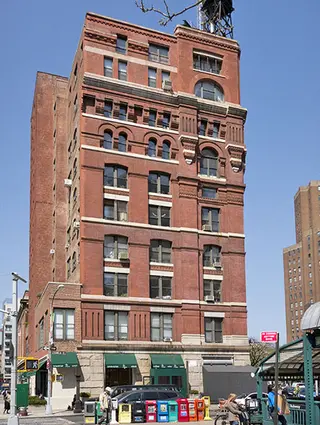 Carter Horsley
Carter HorsleyDec 18, 2017
Carter's Review
This handsome, 10-story, 19th Century, red-brick building at 6 Varick Street just to the north of Finn Square at Franklin Street and West Broadway has 24 co-operative apartments.
It was built in 1882 for the Francis H, Leggatt Stores, importers of teas and coffees, and designed by George de Cunha.
When the Leggatt enterprise moved, the building became known as the Comet Warehouse Building and later it was occupied by All American Cables and Radio Inc., and the Mackay Radio & Telegraph Company.
It was converted to residential use in the late 1980s and its ground floor has various stores.
According to the December 6, 2012 “Streetscapes” column in The New York Times by Christoper Gray, “Finn Square had a violent birth: as Seventh Avenue and Varick Street were widened and extended south to connect with West Broadway, the buildings on the east side of Varick were cut back 35 feet.”
(“It namesake was Philip S. Finn, one of seven young men form Lower Manhattan who died in 1918 at Luneville, France, simultaneously killed by an artillery shell. He was the son of Daniel Finn, a magistrate.”)
Bottom Line
Close to the popular Odeon restaurant on West Broadway and the charming Duane Park a couple of blocks to the north, this building, although only half of its former self, is a very handsome TriBeCa tower on the north side of the small and triangular Finn Square park with its attractive subway station entrance.
Description
The widening, the article continued, “butchered” the Leggatt building “and its scarred west wall, although later given windows and store spaces, bears testimony to the brutality that can accompany civic improvement.” Mr. Gray described the Queen Anne-style Leggatt building as “a red-brick monster with the aspect of a medieval fort,” adding that it originally has “a complex mansard roof…that burned in 1891 in a fire accelerated by the oils and alcohol used the preparation of spices and extracts.”
Da Cunha’s Leggatt Building really was not a “monster” as it has a nicely rusticated granite base and lively façades with numerous arches of different sides and stringcourses that danced between slightly arched windows on the fourth and sixth floors, and fluted and inverted pilasters between windows on the second floor.
The seventh floor had projecting corners with pairs of small arched windows in the center of its façades with three stringcourses all beneath the rugged brackets on the eighth floor separating small windows under a large bandcourse.
The 10th floor has a large arched window at a northern corner beneath four narrow windows on the quite short top floor.
Subsequently, fire escapes were added to the top four floors along West Broadway and watertanks at the building’s southeast and northwest corners.
C. P. H. Gilbert, who was known for his mansion designs, remodeled much of the scarred west façade with some windows but made not effort to match the elaborate robustness and detail of the rest of the building.
This area has changed substantially now Finn Square strollers can look up to the southeast and gawk at the ratchety balconies of Herzog & de Meuron’s 56 Leonard Street, one of Lower Manhattan’s most visible and impressive modern landmarks.
Even before 56 Leonard Street’s jutting silhouette was completed, Mr. Gray noted that “because of the low-slung Con Ed stations on the east, the wide-open space of Finn Square is flooded with sun, unlike much of densely built TriBeCa,” adding that “surrounded by architecture of several different decades, it is a good place for the architectural pilgrim to go at midday for a good doze.”
Such pilgrims should also enjoy the night-time splendors of the still emerging Lower Manhattan skyline.
Amenities
The building has a roof deck, a bicycle room, an intercom, storage and a washer/dryer. It allows cats and dogs.
Apartments
Because its east and west façades are angled, the building has many angled layouts.
Apartment 8A is a two-bedroom unit with a 31-foot-long living/dining room with an angled window and a 13-foot-long open kitchen with a breakfast bar, a 13-foot-long library, a 12-foot-long office and a 12-foot-long laundry.
Apartment 1B is a two-bedroom unit with a 9-foot-wide entry foyer that opens onto a 12-foot-wide, open kitchen and a 26-foot-long living/dining room with a large curved terrace.
Apartment 4B is a one-bedroom unit with a 33-foot-long angled living room with an angled entry foyer, an angled bedroom, a 14-foot-long dining area and an angled, 11-foot-long, open kitchen.
Apartment 2B is a one-bedroom unit with a 10-foot-wide entry foyer that leads to a 17-foot-long, angled living room adjacent to a 21-foot-long, angled dining room and an open 13-foot-long kitchen with a breakfast bar.

- Condop built in 1915
- Located in Tribeca
- 24 total apartments 24 total apartments
- 10 recent sales ($395.4K to $4M)
 6sqft delivers the latest on real estate, architecture, and design, straight from New York City.
6sqft delivers the latest on real estate, architecture, and design, straight from New York City.
